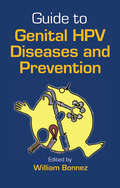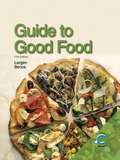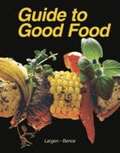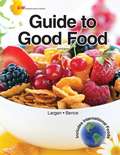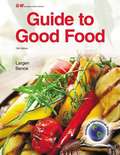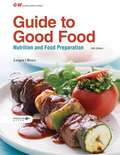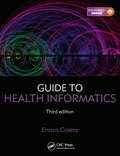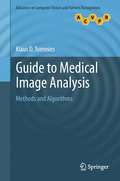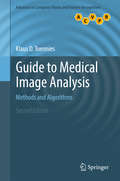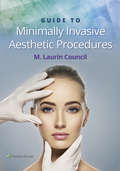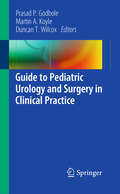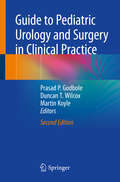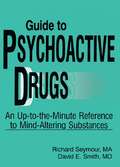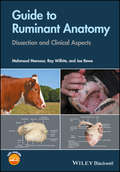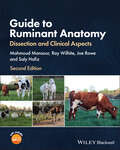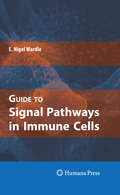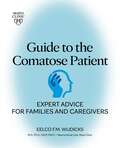- Table View
- List View
Guide to Genital HPV Diseases and Prevention: Diseases And Prevention
by William BonnezCustom-designed for clinicians on the frontline of treatment and prevention of the human papillomavirus (HPV), this stand-alone handbook provides the scientific background needed to understand and administer the new HPV vaccines. Written by some of the discoverers of these vaccines, this accessible text explores the biology and epidemiology of HPV,
Guide to Good Food
by Deborah L. Bence Velda L. LargenGuide to Good Food is designed to give you information about food and nutrition you can use every day. This practical text focuses on the latest advice on diet and physical activity to help you make healthful food and fitness choices. Guidelines for choosing appliances, setting up a food budget, and buying and storing foods will help you make consumer decisions. Tips on using space, time, and energy will help you manage your resources while working in the kitchen. Information on basic cooking methods will give you the background needed to prepare a wide range of foods.
Guide to Good Food
by Deborah L. Bence Velda L. LargenStudents will learn how to select, store, prepare, and serve foods while preserving their nutrients, flavors, textures, and colors.
Guide to Good Food
by Deborah L. Bence Velda L. LargenStudents will learn how to select, store, prepare, and serve foods while preserving their nutrients, flavors, textures, and colors.
Guide to Good Food
by Deborah L. Bence Velda L. LargenGuide to Good Food gives your students an in-depth look at the exciting world of food and the MyPlate food guidance system. This edition incorporates the latest Dietary Guidelines for Americans as it shows students how to select, store, prepare, and serve nutritious, appealing dishes. Eachchapter includes a profile of one of the many food-related careers available. Students further investigate career and job success in two new career-related chapters and in brief Career Success features throughout. The extensive Foods of the World section has tabbed pages that allow students to conveniently explore the culture and cuisine of over 30 countries. Menus and recipes with step-by-step directions as well as nutritional analyses are included. New to this edition are A Measure of Math and Teamwork in Action activities at the end of each chapter. Within the chapters are new features on the following topics: * Global Perspective * Health and Wellness * Food Science * Culture and Social Studies
Guide to Good Food
by Deborah L. Bence Velda L. LargenGuide to Good Food provides an in-depth look at how to select, store, prepare, and serve nutritious, appealing dishes. Menus and recipes with easy-to-follow, step-by-step directions and nutritional analyses are included. Food-related careers are profiled in every chapter, and Career Success features are found throughout. Healthful lifestyles are supported by the inclusion of MyPlate and the latest Dietary Guidelines for Americans. Students can explore the culture and cuisine of over 30 countries in the Foods of the World section. Math, food science, and social studies are introduced into the curriculum through features and activities.
Guide to Good Food: Nutrition and Food Preparation
by Deborah L. Bence Velda L. LargenGuide to Good Food: Nutrition and Food Preparation employs current nutrition information to inform students as they learn the roles nutrients play in their health throughout the life cycle. Comprehensive content on food selection, storage, preparation, and service gives students the tools needed to recognize and follow a nutritionally balanced diet, while animations bring content to life. Menus and recipes with easy-to-follow, step-by-step directions, and nutritional analyses are also included. Food-related careers are profiled in every chapter. * Enhanced visuals program employs infographics and images to emphasize content and improve recall. * The Foods of the World section explores the culture and cuisine of over 30 countries. * Students can complete and submit review questions digitally, enhancing instructor's assessment of students' comprehension and reducing paper waste.
Guide to Health Informatics
by Enrico CoieraThis essential text provides a readable yet sophisticated overview of the basic concepts of information technologies as they apply in healthcare. Spanning areas as diverse as the electronic medical record, searching, protocols, and communications as well as the Internet, Enrico Coiera has succeeded in making this vast and complex area accessible and understandable to the non-specialist, while providing everything that students of medical informatics need to know to accompany their course.
Guide to Health Informatics
by Enrico CoieraThis essential text provides a readable yet sophisticated overview of the basic concepts of information technologies as they apply in healthcare. Spanning areas as diverse as the electronic medical record, searching, protocols, and communications as well as the Internet, Enrico Coiera has succeeded in making this vast and complex area accessible and understandable to the non-specialist, while providing everything that students of medical informatics need to know to accompany their course.
Guide to Medical Image Analysis
by Klaus D. ToenniesThis book presents a comprehensive overview of medical image analysis. Practical in approach, the text is uniquely structured by potential applications. Features: presents learning objectives, exercises and concluding remarks in each chapter, in addition to a glossary of abbreviations; describes a range of common imaging techniques, reconstruction techniques and image artefacts; discusses the archival and transfer of images, including the HL7 and DICOM standards; presents a selection of techniques for the enhancement of contrast and edges, for noise reduction and for edge-preserving smoothing; examines various feature detection and segmentation techniques, together with methods for computing a registration or normalisation transformation; explores object detection, as well as classification based on segment attributes such as shape and appearance; reviews the validation of an analysis method; includes appendices on Markov random field optimization, variational calculus and principal component analysis.
Guide to Medical Image Analysis
by Klaus D. ToenniesThis book presents a comprehensive overview of medical image analysis. Practical in approach, the text is uniquely structured by potential applications. Features: presents learning objectives, exercises and concluding remarks in each chapter, in addition to a glossary of abbreviations; describes a range of common imaging techniques, reconstruction techniques and image artefacts; discusses the archival and transfer of images, including the HL7 and DICOM standards; presents a selection of techniques for the enhancement of contrast and edges, for noise reduction and for edge-preserving smoothing; examines various feature detection and segmentation techniques, together with methods for computing a registration or normalisation transformation; explores object detection, as well as classification based on segment attributes such as shape and appearance; reviews the validation of an analysis method; includes appendices on Markov random field optimization, variational calculus and principal component analysis.
Guide to Minimally Invasive Aesthetic Procedures
by M. Laurin CouncilAmid today’s growing demand for cosmetic medicine, Guide to Minimally Invasive Aesthetic Procedures provides a reliable, up-to-date, and highly illustrated guide to the wide variety of aesthetic procedures commonly requested and performed in this fast-changing field. This easy-to-follow manual offers a quick, practical introduction to the optimal use of everything from botulinum toxin and deoxycholic acid to injectable fillers and laser and light devices.
Guide to Nursing's Social Policy Statement: Understanding the Profession from Social Contract to Social Covenant
by Marsha D. M. FowlerNursing is often called a helping profession: Nursings Social Policy Statement is about the many ways that nursing helps others. It is about the relationship the social contract between the nursing profession and society and their reciprocal expectations. This arrangement authorizes nurses as professionals to meet the needs involved in the care, and health of patients and clients and the health of society. It helps nurses engage in the political and legislative action that supports nursing education, research, and practice to better influence that health and care; and to understand the social ethics and justice that affect global and individual health. But what does that mean now? The new Guide to Nursings Social Policy Statement unpacks it for the 21st century nurse: Social contract in theory and practice Nursings own social contract and its 16 distinct elements Nursing and the common good and what constitutes the common good today Citizenship, civic engagement, and civic professionalism of nurses Professions and what they are, how they can get broken and mended, and nursing as a profession The interplay of the Code of Ethics for Nurses with Interpretive Statements and Nursings Social Policy Statement Nursings social covenant (by which nursing goes beyond its social contract) Nursings involvement in public and global health Suitable for courses and professional development activities in nursing curriculum, ethics, leadership, research, and role development, the Guide to Nursings Social Policy Statement clarifies foundational concepts of the nursing society relationship, the breadth of ways in which nurses might exercise their passion for the profession, a vision for nursings social evolution, and much more!
Guide to Paediatric Haematology Morphology
by Gillian RozenbergThis illustrated guide to identifying or confirming blood disorders in paediatric patients presents examples of the abnormal morphology involved. Clinicians in both haematology and paediatrics will find this an invaluable resource. Provides an authoritative visual guide for standard morphology in paediatric haematology disorders. Offers a reliable guide for registrars in haematology and paediatrics. Presents expert guidance for clinical identification and confirmation of diagnoses.
Guide to Pediatric Urology and Surgery in Clinical Practice
by Martin Koyle Duncan T. Wilcox Prasad P. GodboleGuide to Pediatric Urology and Surgery in Clinical Practice addresses the surgical and urological problems in children that may be encountered in the primary care clinic. Divided into two sections on urology and surgery, the chapters give a synopsis of a particular condition, its management in primary care, indications for referral and timing of referral. Complications of a particular procedure and its management if presenting to primary care is also discussed. The book is illustrated throughout and key points are provided at the beginning of each chapter for quick and easy reference. A concise assemblage of all those pediatric surgical and urological conditions commonly encountered in primary care, this book provides a quick reference guide for use in clinical practice.
Guide to Pediatric Urology and Surgery in Clinical Practice
by Martin Koyle Duncan T. Wilcox Prasad P. GodboleThis extensively revised second edition provides a quick reference guide to pediatric surgical and urological problems encountered in the primary care clinic. Chapters cover recent updates in the field and give a synopsis of a particular condition, its management in primary care, indications for referral, and timing of referral. Guide to Pediatric Urology and Surgery in Clinical Practice features a concise collection of pediatric surgical and urological conditions commonly encountered in primary care, and is a valuable resource for primary care practitioners, medical students, pediatricians and residents in pediatrics.
Guide to Psychoactive Drugs
by David E Smith Richard B SeymourInvaluable clinical and treatment information on the most powerful mind-altering drugs in use today. Compiled by two leading professionals from the renowned Haight Ashbury Clinic, the information is based on national and international studies undertaken at the clinic, as well as from 600,000 patient visits, a thorough review of practice and background as reported in the literature, and from their own private practices. An up-to-date reference source, this important guide includes information on the trademark, generic, and popular names of drugs; the use and abuse of drugs; and their acute and chronic effects. An innovative index and cross reference system provide quick, easy access for the physician who must act quickly in an emergency.
Guide to Ruminant Anatomy: Dissection and Clinical Aspects
by Joe Rowe Mahmoud Mansour Ray WilhiteGuide to Ruminant Anatomy: Dissection and Clinical Aspectspresents a concise, clinically relevant reference to goat and cattle anatomy, with color schematic illustrations and embalmed arterially injected prosection images for comparison. Offers 244 color images depicting goat and cattle anatomy Provides selected line drawings correlated to dissection images of embalmed arterially injected specimens Takes a practical approach, with material organized by body system within each region Demonstrates the clinical relevance of basic anatomy Poses review questions in each chapter, with answers and videos provided on a companion website
Guide to Ruminant Anatomy: Dissection and Clinical Aspects
by Thomas PasslerGuide to Ruminant Anatomy Familiarize yourself with the anatomy of ruminants and food animals with this up-to-date guide Guide to Ruminant Anatomy provides a richly illustrated guide tailored to the practical needs of veterinary clinicians. Divided for ease of use into sections representing different parts of the ruminant body, this in-depth introduction uses real dissection images to familiarize readers in detail with the internal and external anatomy of caprine, ovine, and bovine animals. It provides an outstanding demonstration of the relevance of anatomy in clinical settings. Guide to Ruminant Anatomy readers will also find: Practical clinical applications discussed by board certified clinicians in each chapter Line drawings corresponding to dissection images of embalmed specimens Learning objectives in each section, tying key concepts to clinician development A companion website featuring laboratory videos demonstrating relevant anatomy Guide to Ruminant Anatomy is an essential guide for veterinary students studying anatomy of food animals, as well as veterinary practitioners of all kinds looking for an easy-to-use reference on ruminant anatomy.
Guide to Signal Pathways in Immune Cells
by E. Nigel WardleThis guide provides vital information on white cells and covers such topics as neutrophils and macrophages, T and B lymphocytes, natural killer cells and mast cells. The book aims to extend understanding of the basic signal transduction pathways.
Guide to the Code of Ethics for Nurses with Interpretive Statements: Development, Interpretation, and Application
by Marsha D. M. FowlerThis is an essential resource for nursing classrooms, in-service training, workshops and conferences, self-study, and wherever nursing professionals use ANA’s Code of Ethics for Nurses with Interpretive Statements in their daily practice. Each chapter of this comprehensively revised text is devoted to a single Code provision. For convenience of reference, the text of ANA’s Code of Ethics for Nurses with Interpretive Statements is included as an appendix. This book will challenge each nurse to achieve deeper professional and personal understanding, and will provide a foundation for professional pride. From the classroom to professional practice, nurses in all roles or settings will find this book to be a powerful tool for learning how to examine and apply the values, duties, ideals and commitments of their living ethical tradition to their practice.
Guide to the Comatose Patient: Expert advice for families and caregivers
by Dr. Eelco WijdicksCaring for a loved one in a coma is a distressing time, full of many questions, and often, not as many answers. Guide to a Comatose Patient is a first-of-its-kind book that steps into the shoes of the neurologist, to show the perspective of the staff caring for their loved ones — what worries us, how we think and intervene, what we can and cannot predict, and what we know as a certainty.In our hospital ICUs, there are more than a dozen comatose patients at any given point of time. Causes of coma can range from drug-induced coma—in which medications are used to calm the patient and allow the ventilator to work properly—to coma due to intoxication and coma related to a brain injury. No matter the reason, it can be a distressing time for loved ones. Guide to a Comatose Patient is a helpful guide for any family member or loved one confronted with coma. Author Eelco F. M. Wijdicks, M.D., Ph.D., a leading neurologist and attending neurointensivist at Mayo Clinic, begins each chapter by sharing helpful anecdotes from a career spanning four decades, before diving into the answers to commonly asked questions, such as: · What are the causes of coma? · When will the patient wake up and recover? · When is no recovery expected? · When should we consider organ donation? · What are the rates of survival? While there are many books on families&’ experiences with acute traumatic brain injury and coma, Dr. Wijdicks offers an unusually candid conversation that allows a peek inside the minds of the doctors caring for your loved one. Having had many experiences talking to families having to make difficult decisions at a very difficult time, Dr. Wijdicks&’s message is hopeful while remaining grounded in reality—a reality in which facts must dictate actions. Guide to a Comatose Patient provides important information so that families better understand treatment options, but most importantly, the book offers an open dialogue and optimal transparency to help provide hope and healing through times of grief.
Guide to the De-Identification of Personal Health Information
by Khaled El EmamOffering compelling practical and legal reasons why de-identification should be one of the main approaches to protecting patients' privacy, the Guide to the De-Identification of Personal Health Information outlines a proven, risk-based methodology for the de-identification of sensitive health information. It situates and contextualizes this risk-ba
Guide to the Healthcare Industry (SAGE Works)
by Karen PellegrinHealthcare′s advancements are undeniable, but delivering good value remains a challenge. Costs rise while quality improvements lag, leading some to call for removing business from healthcare entirely. This book offers a different perspective, inviting students and professionals to consider the potential of evidence-based business practices to improve healthcare and reduce costs. This engaging guide explores the unique complexities of the healthcare industry, highlighting why it′s ripe for disruption through innovative business solutions. By delving into how traditional models might not fit healthcare perfectly, the book paves the way for understanding how better business practices can unlock the potential for higher quality care at a lower cost.
Guide to the Healthcare Industry (SAGE Works)
by Karen PellegrinHealthcare′s advancements are undeniable, but delivering good value remains a challenge. Costs rise while quality improvements lag, leading some to call for removing business from healthcare entirely. This book offers a different perspective, inviting students and professionals to consider the potential of evidence-based business practices to improve healthcare and reduce costs. This engaging guide explores the unique complexities of the healthcare industry, highlighting why it′s ripe for disruption through innovative business solutions. By delving into how traditional models might not fit healthcare perfectly, the book paves the way for understanding how better business practices can unlock the potential for higher quality care at a lower cost.
